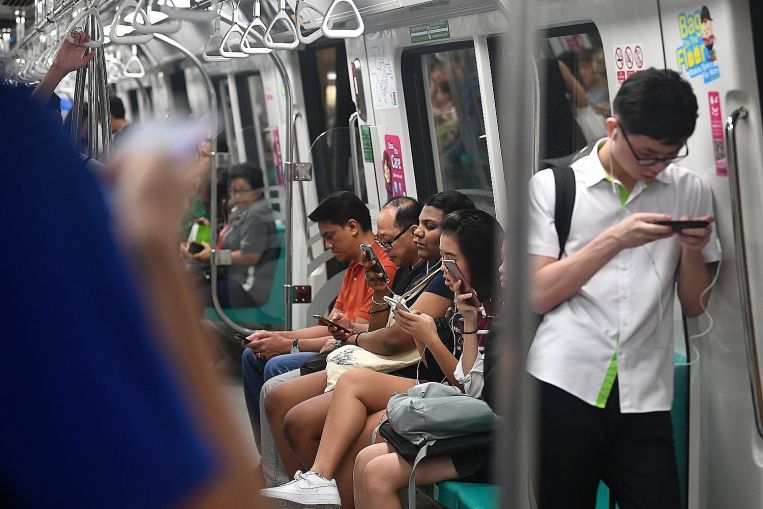Next year, Singapore will issue licences to operate up to four 5G networks, instead of the two initially planned for, as it takes bolder steps to embrace a technology believed to be crucial to the nation’s economic growth.
All four networks can be rolled out by next year to provide spot coverage, although nationwide coverage will take much longer and be limited to only two networks because of the scarcity of 5G airwaves for islandwide reach. Nationwide reach is possible only in 2021, when these airwaves become available.
Some of the 5G airwaves are currently used for satellite communications by countries such as Malaysia and Indonesia.
The Infocomm Media Development Authority (IMDA) rolled out more aggressive plans after a two-month-long public consultation earlier this year, during which calls were made for the involvement of all four telcos here – Singtel, StarHub, M1 and TPG Telecom – to spur innovation and competition.
Operators must submit detailed proposals by next month, after which 5G airwaves will be assigned. The proposals for the two nationwide networks, for instance, will be assessed on factors such as network security design and ability to achieve 50 per cent islandwide coverage by end-2022.
Why it matters
IMDA had planned to give out licences to operate only two 5G networks built with the most advanced technologies that do not piggyback on existing 4G technologies, and allows for nationwide coverage.
But its plan would have taken a long time to roll out because of the scarcity of airwaves that enable nationwide reach.
“Singapore is already slower than South Korea, China and the United States, which have launched 5G services using a combination of the far-reaching 3.5Ghz airwaves as well as the millimetre airwaves,” said Mr Sachin Mittal, head of telco research at DBS Bank. The 3.5Ghz band is scarce in Singapore.
The alternative is to give out more licences to run smaller 5G networks and more millimetre airwaves to support their roll-out.
Millimetre airwaves are in abundance in Singapore, and 5G networks built using these can be rolled out as quickly as next year.
The smaller 5G networks will meet immediate industrial needs – for example, in smart ports and factories to remotely operate cranes or vehicles to move shipping containers or goods round the clock.
5G technology promises surfing speeds 20 times faster than what 4G networks offer and the ability to connect 1,000 times as many devices.
Port operator PSA International is already working with Singtel and M1 to conduct trials to explore the use of driverless vehicles to move shipping containers round the clock. This will allow PSA to load and unload more containers and turn ships around faster.
The telcos will also set up trials for the remote control of port equipment such as cranes. The trials will pave the way for the building of a state-of-the-art Tuas Port, expected to open from 2021 in stages, to reinforce Singapore’s position as a leading port in the region.
Smaller 5G networks will also be useful for consumer applications like virtual reality and augmented reality gaming, said Mr Ramakrishna Maruvada, a regional telecoms analyst at Daiwa Capital Markets.
He noted that telcos could monetise these applications before spending more money to roll out the full-fledged 5G networks.
Singapore still wants to be among the front runners in the roll-out of next-frontier applications, possible only through a full-fledged 5G network that does not piggyback on 4G technologies.
The technology promises surfing speeds 20 times faster than what 4G networks offer and the ability to connect 1,000 times as many devices.
A full-fledged 5G network built independent of 4G technologies will also be able to support critical applications such as driverless car navigation and remote surgery that require a constant connection without lag.
Several projects have qualified for grants from a $40 million fund set up by the National Research Foundation and the IMDA to accelerate Singapore’s 5G rollout plans.
One of the projects is in smart mobility involving real-estate firm CapitaLand, map-service provider Navinfo Datatech and telco TPG Telecom. They are testing cloud-based driverless car navigation at Science Park 1 and and 2 over a 5G connection.
By moving the processing of traffic data from an in-vehicle system to a cloud system, it is hoped that the cost of autonomous vehicles can be reduced.
What lies ahead
The race for 5G supremacy is linked to economic progress, and is at the centre of an ongoing trade war between the United States and China.
The United States has been trying to stop its allies from using 5G mobile systems supplied by Huawei, citing espionage concerns. It says it will evaluate how to share intelligence with governments that have 5G networks using equipment from “untrusted vendors”, referring to Huawei.
Unlike some countries which have banned Huawei over espionage concerns, Singapore has not barred any vendor. With the US its biggest investor and China its largest trading partner, taking sides will not benefit the Republic. But Singapore has laid down conditions, such as requiring 5G systems to meet security requirements.
It has also insisted that the two 5G networks with nationwide coverage are built with the most advanced technologies that do not piggyback on existing 4G technologies. This will give local telcos an opportunity to pick equipment suppliers from scratch. Any “lock-in” to existing 4G vendors for a cheap and quick migration to 5G – an advantage that Huawei has over rivals – will not be able to influence telcos’ long-term decisions on 5G.
The prolonged US-China trade war continues to threaten to splinter the tech world and hamper global economic cooperation.
The first tech casualty is the Mate 30 launched here last month – the first smartphones from Huawei to be without Google apps and services due to a US government ban earlier this year which forbids American firms from doing business with the Chinese tech company. Instead of Android, the Mate 30 phones run on Huawei’s in-house developed operating system.
A splintered tech world is not totally unfamiliar to most people. China has already created an alternate universe for apps and services behind its great firewall designed to keep out foreign firms’ influence on domestic tech consumption.
For instance, Baidu is the equivalent of Google for online search activities in China, while Weibo rivals micro-blogging platform Twitter. The Chinese have also created Renren, which is similar to Facebook.
An alternate universe could be created for hardware as China develops its own components to wean itself off third parties like Intel, Qualcomm, Xilinx and Broadcom.
This means the world could end up with two hardware and software ecosystems, possibly leading to inter-operability issues reminiscent of the past.














